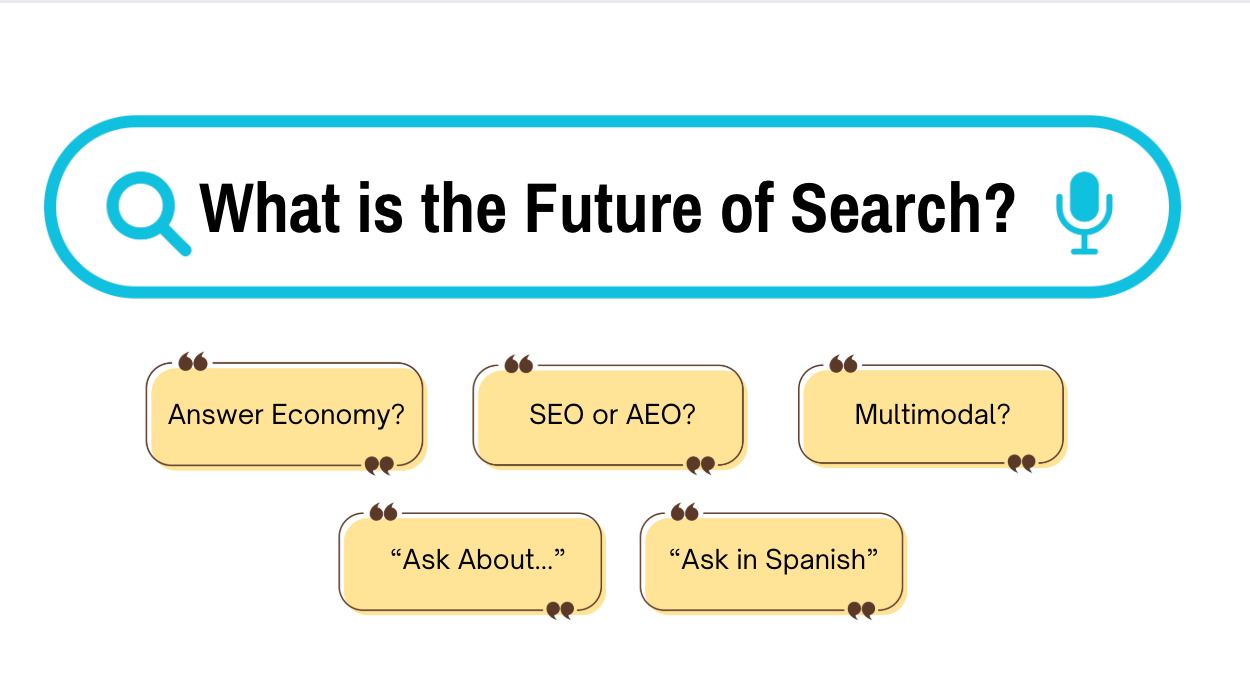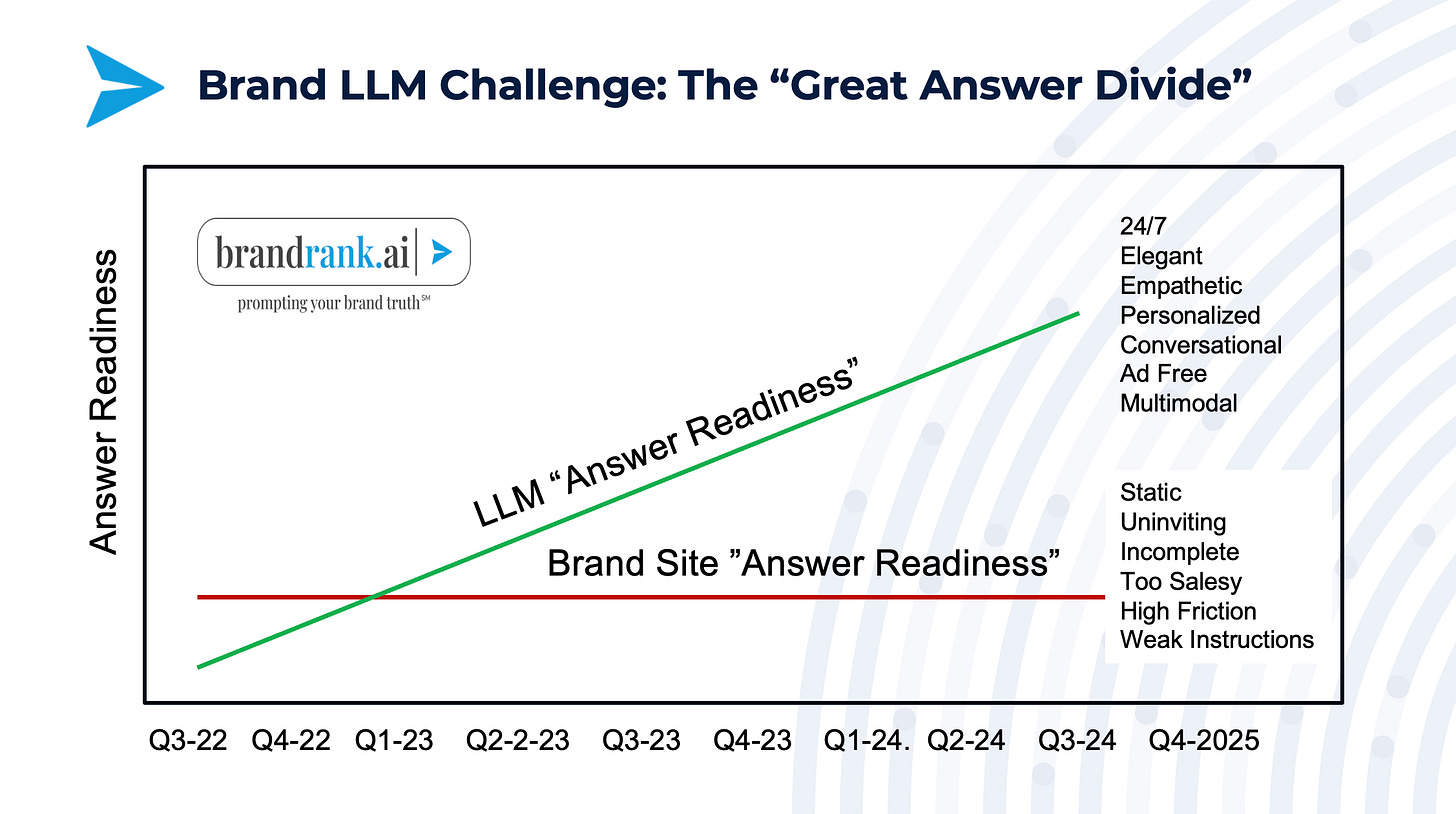Every day, humans conduct approximately 9 billion searches – and AI is about to fundamentally disrupt this $200 billion industry. The 'ten blue links' paradigm that defined a generation of digital marketing is ending.
Having witnessed digital transformation from multiple vantage points – from leading P&G's first interactive marketing team to spearheading Digital Worldwide at Nestlé, and now as co-founder of an AI startup – I can tell you this shift is different – and far more consequential.
Google's CEO
recently stated that "2025 will be about making AI apps like Gemini the point of contact between users and search." The data backs this up: according to a BrandRank.AI study, 59% of GenAI users are already moving away from traditional search engines, marking a seismic shift in how people seek information. The stakes are even higher: Gartner projects that by 2028, AI-powered search will reduce brands' organic site traffic by 50% or more, with 70% of consumers already showing strong trust in GenAI search results.The Answer Economy and the Great Answer Divide
We've entered what I call the "Answer Economy." LLMs are fundamentally answering questions at scale...and in every possible manner. Questions are the new entry point to shoppers, consumers, brand growth opportunities. Yet this creates a crisis I've been warning about: the Great Answer Divide. Most brands remain answer-arthritic – stuck with rigid, campaign-driven content structures that can't keep pace with consumer expectations for immediate, accurate, real-time, contextual information.
This divide isn't just about technology – it's about response capability. While AI systems can synthesize complex information and deliver contextual answers in milliseconds, many brands are still operating like it's 2010, relying on static FAQs and outdated content strategies. The gap between what consumers can learn about your brand from AI and what you're equipped to answer directly is widening daily.
, my partner and co-founder of BrandRank.AI and an early pioneer in search optimization at , predicts that "sponsor and click models for answer engines will emerge by the end of the year with rapid adoption." But here's the uncomfortable truth: even if brands can buy their way into these answer engines, they'll need fundamentally different content architectures to succeed.Let me be clear: this isn't just another digital transformation challenge. It's an existential threat to brand authority. When AI can provide better answers about your products than you can, you've lost control of your narrative.
The Website Renaissance
Here's the surprising twist: brand websites, often neglected in favor of social media and e-commerce, are emerging as the primary 'algorithmic anchor' for AI search outcomes. Our audits consistently show brand sites ranking #1, outperforming Wikipedia, reviews, and other sources.
During my tenure at Nestlé, @Wikipedia was our algorithmic anchor for Google search rankings – sometimes outranking our own brand. But in the AI search era, brand websites are becoming increasingly crucial. This carries significant implications for CMOs:
Owned media, particularly domain content, will benefit from rich, searchable, and technically optimized content
FAQs are now your front line of communication with both consumers and AI bots
Brand recognition in AI systems requires transparent, timely, and clear content
The Evolution of Search Interactions
Today's search landscape transcends text. As
, a seasoned observer of the tech industry, notes,"The meaning of 'search' is evolving to encompass multimodal and contextual interactions." Indeed, platforms like ChatGPT, @Perplexity AI, Claude, and X/Grok already integrate voice, images, and audio for richer interactions. We’re also seeing a shift from reactive to predictive search. ChatGPT's recent video capability, as you see in this demo I recently posted, is effectively a real-time visual FAQ.Search is becoming more predictive. This is especially evident in the relatively new Amazon Rufus shopping assistant, which seamlessly takes early intent data and predicts likely next choices. Even from a B2B perspective, you can imagine a procurement manager looking up industrial equipment specifications and immediately receiving proactive suggestions about compliance requirements, maintenance schedules, and compatible systems – all before they've explicitly asked these questions.
Building an AI-Ready Content Strategy
Your content strategy needs a complete overhaul for the AI age, and it must seamlessly blend technical optimization with content excellence. Here's what works:
Step 1: Listen to the AI Engines
Start by understanding what AI engines are saying about your brand and why. While tools like BrandRank.AI can provide comprehensive analysis, you can begin with hands-on keyboard exploration of how different AI systems represent your brand, products, and key topics. These insights should form the foundation of your content strategy.
Step 2: Structure for Questions and Answers
Adopt an answer-first approach by structuring your content ecosystem around specific customer questions. This means reimagining your content architecture to provide clear, authoritative answers that both AI systems and consumers can easily process. Schema markup and entity relationships form the technical foundation that makes this possible.
Step 3: Open Your Information Vault
Open your product information vault. AI systems excel at contextualizing complex technical details, so share everything from manufacturing processes to specifications. Open up your sustainability and supply chain metrics. The more comprehensive your content, the more likely AI systems will recognize your brand as the authoritative source.
Step 4: Keep Content Fresh and Connected
Keep your content fresh and connected. AI systems prioritize regularly updated content and understand context through relationships. Build connections between your content and authoritative external sources while maintaining a systematic update schedule. Remember: in the AI era, static content is invisible content.
Step 5: Measure Your AI Search Visibility
Close the loop by measuring how AI systems represent your brand over time. While we do this comprehensively for brands at BrandRank.AI, you can start by systematically tracking your brand's presence in AI responses to key customer questions. Test different content approaches, measure the impact, and continuously refine your strategy based on what works.
Looking Ahead
Here's something that might surprise you: as AI search becomes more prevalent, human expertise becomes more valuable, not less. Your subject matter experts who can articulate complex topics clearly are crucial for AI-ready content creation. Their knowledge needs to be captured and structured in ways that AI systems can understand and distribute.
Success will come to those who think like algorithms while maintaining authentic human connections. But here's the mindset shift you need to make: stop thinking solely about SEO (Search Engine Optimization) and start embracing AEO (Answer Engine Optimization). While traditional SEO focuses on ranking in a list of blue links, AEO is about becoming the authoritative source that AI systems turn to for answers.
Remember this: in the AI search era, your brand isn't just competing for attention – it's competing for understanding. The winners won't be those who master keywords and backlinks, but those who make themselves most comprehensible to both artificial and human intelligence.
The future belongs to brands that can answer, not just rank.





